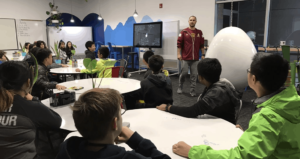Why I’m Post Policy and Pro-Innovation

The last quarter century of US education was a bet on policy–and it didn’t work. At least not as well as hoped. The trifecta of standards-based reform included:
- Clear higher learning expectations–what became college readiness for all;
- Valid, reliable and cheap measures of student proficiency in reading and math; and
- Progressive school accountability from support to restart.
The bipartisan push for better and more equitable outcomes was well-intentioned, even inspiring. And, as former chief (i.e., head of CCSSO) Gene Wilhoit reminded a group last week, a lot of good came from the effort:
- Better, clearer, and higher standards,
- A commitment to equity,
- Practice informed by data, and
- A recognition of the importance of good teaching
But the unintended consequences of the standards movement were numerous. And, even with the new found freedom, a lot of educators suffer from PTSD from a narrow focus on testing in compliance-oriented systems that drove out creativity and collaboration rather than encouraging them.
Reflecting on the American education journey (and my own attempts at shaping it) yields a sense of humility about the big lever of public policy.
It’s ironic that the 25 years of standards-based reform coincided with and overshadowed the beginning of the anyone-can-learn-anything digital learning era.
Preference for what is proven ignores that what is proven was once experimental. Here are seven reasons to support innovations in learning:
1. New tools. With increased investment ($3B of venture capital last year) new tools, and the learning models they enable, are changing the opportunity set.
There should be spaces and resources for innovations with the potential to boost life outcomes.
2.Personalized learning is promising. We’re in the early first few years of reconceptualizing education as a personal journey tailored to each learner’s needs and motivational profile.
A focused R&D agenda on personalized learning models would produce huge public benefit.
3. Broader aims are mission critical. We’re in the early innings of defining, adopting broader aims of success including self-management, social awareness, and mindsets. A common lexicon and feedback framework for success habits and character strengths will clarify priorities for schools and learners.
Adding habits of success to basic skills development helps reconceptualize the purpose of schooling.
4.You can’t legislate innovation. It is possible to improve conditions for learning, but the unintended consequences of a mandated framework or legislated innovation suggest caution.
Innovation can be invited, incentivized and encouraged but not legislated.
5. Real-time feedback. The transition from print to digital made formative assessment nearly ubiquitous—many students and teachers are benefiting from continuous feedback. But it is still hard to combine formative feedback in ways that inform learning and mastery judgments. New platforms, portfolios and learner profiles will make it easier to store and organize evidence and artifacts of learning.
Learners deserve accurate real-time information about their progress and options.
6. Choice of experiences. Learning opportunities have shifted from school choice to course choice to experience choice. Taking full advantage of options at the unit and experience level will require performance-based funding that follows the student, better parent and student information systems that surface and recommend best options to help guide informed choices, and advisors (learning Sherpas) that help students and families make good choices will be critical in making effective use of expanded options.
Policy should support informed learner opportunity.
7. Toward competency. The world is moving towards a “show-what-you-know” economy with demonstrated competency signaled through a variety of strategies (e.g., microcredentials and portfolios).
Learners should show what they know and progress on mastery.
Here’s the rub: innovation always creates inequity–at least temporarily. Some schools get cool tools while others can’t afford the transition. As technology drops in cost, it benefits more people. Just look at the growth of global connectivity. New tools have helped lift a billion people from dire poverty in the last 15 years. By 2020, 7 billion people will be connected to the Internet.
NCLB was a national policy attempt to build a floor of equitable opportunity. It produced some benefit, but inhibited innovation to the extent that it may have reduced rather than increased access to powerful learning experiences. The experience should at least make us cautious of efforts to mandate equity.
The seven areas of opportunity sketched out above suggest that states and regions should pursue an innovation agenda taking advantage of the power of networks of like-minded schools.
The last two decades of US education were framed by federal policy. The next two decades will be framed by the hunch that personalized pathways of learning can be far more powerful and productive than the way we have historically organized school–we just need to invent the tools and methods to do it well and at scale. And, perhaps, in this way we can provide the equity of opportunity sought in the NCLB consensus.
For more, see:
- 6 Ways States Can Redefine Student Success and Transform Education Under ESSA
- The First 100 Days: an Education Blueprint for a Dynamic Economy
- Fostering Academic Success for All
Stay in-the-know with all things EdTech and innovations in learning by signing up to receive the weekly Smart Update.







Stephanie Loomis
This resonates with me. I am just completing my second year in a PhD program,, researching the affordances of digital literacy. I want to connect the possibilities of online space to teacher voice and agency in a time when teachers are often silenced by the demands of high stakes test preparation and data-driven "accountability." Research is pretty clear that one reason for the current teacher shortage is that teachers are no longer allowed to innovate in order to meet the needs of the students in their classrooms. The challenge of equity in a non-equitable world is a tension that many teachers despair of reconciling.